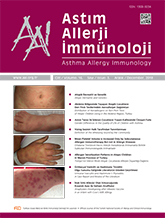


Objective: The spectrum of allergen sensitization differs widely between countries and also regions within the same country. The aim of this study was to investigate the allergen sensitization patterns of atopic children who presented to our allergy clinic.
Materials and Methods: The study retrospectively reviewed all children who presented to our clinic with a suspicion of allergic diseases and had at least one allergen sensitization between January 2014 and January 2017. Clinical diagnosis and atopy markers such as total IgE, serum eosinophil counts, skin prick test (SPT), food and inhalant specific IgE results were evaluated.
Results: A total of 1307 patients were evaluated. The mean age of the children was 9.0±4.4 years and 61.9% were male. Allergic rhinitis was the most common diagnosis with a frequency of 38.9%, followed by asthma (32.9%), urticaria (15.9%) and atopic dermatitis (5.4%). Food mix specific IgE (fx5) positivity was present in 27.6% of patients. The rate of SPT positivity for food allergens was 8.3%. Eggs (4.4%), cow`s milk (2.3%) and peanut (1.7%) were found to be the most common food allergens in SPT. Inhalant specific IgE (phadiatop) positivity was present in 83.0% of the patients. The most common aeroallergens in SPT were Dermatophagoides pteronyssinus (67.9%), Dermatophagoides farinae (67.2%), Alternaria alternata (19.4%) and grass mix (17.7%). Polysensitization was found in 39.5% of the patients. One hundred and eighty seven (14.3%) patients had a negative phadiatop but positive SPT to inhalants. Among them, the most frequent allergens detected in SPT were mites (20.8%), Alternaria alternata (20.3%) and cockroach (11.8%). Among those with Alternaria monosensitization, the serum phadiatop test was negative in 50.8%.
Conclusion: The distribution of allergen sensitizations in atopic children in Mersin province is reported for the first time. Alternaria alternata has emerged as a very important allergen that may be often missed in phadiatop testing.